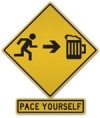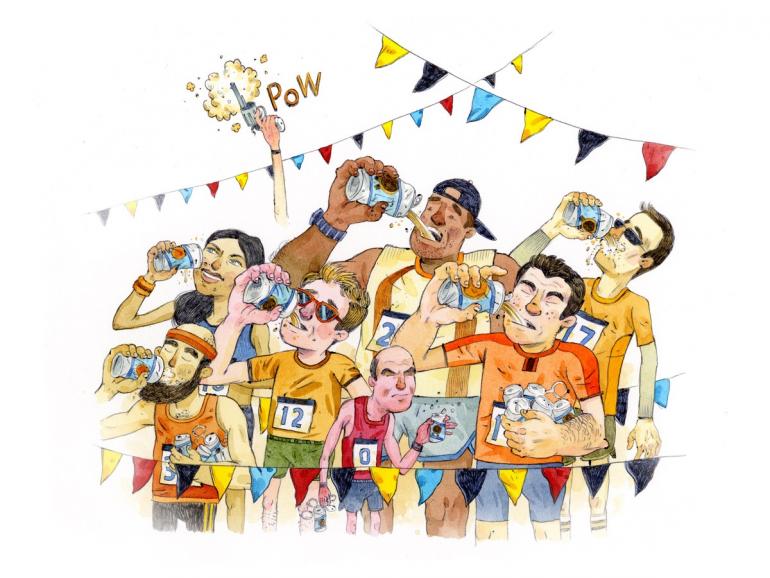Start 14-Day Trial Subscription
*No credit card required

Drink and Run the Healthy Way
No longer confined to pubs with a good beer list, it is not uncommon to find athletes consuming craft beer before, during, and after recreational sporting events, particularly distance running.
Craft has helped spawn events like the Bend Beer Chase in Bend, Oregon. Teams of six combine to run a seventy-mile relay course that visits six local breweries which provide samples along the way.
One of the longest standing traditions of exercise and drinking comes from the Hash House Harriers or H3, an international group of running social clubs. The self proclaimed “drinking club with a running problem” was conceived in 1938 in Malaysia by a group of British colonial officers and expatriates, and patterned after the traditional British game of “hare and hounds”, where the “hare” leaves a trail of paper for the “hounds” to follow. H3’s defined purposes included “to get rid of weekend hangovers” and “to acquire a good thirst and to satisfy it with beer.” The Harriers would do just that upon completion of the chase.
Now the group, named for the “Hash House” where many of the original members lived and dined, includes almost 2,000 chapters worldwide, two on Antarctica.
Recently, a slightly more extreme intersection of drinking and running has gained footing in the form of the Beer Mile, a self-described form of “digestive athletics” centered around chugging a 12-ounce beer, sprinting a quarter mile, and repeating the process three more times as quickly as possible, for a total of one mile. To quote the sport’s leading online authority, www.beermile.com, “the total time is often used as a measuring stick of competency.”
According to the "Kingston Rules", named for the Canadian city where Beer Mile rules were first publicly displayed, any beer may be used provided it is at least 5 percent ABV, and made with malts and hops (hard ciders and lemonades are not allowed).
While canned domestic lagers are most widely implemented, craft beers were used in half of the top ten Beer Mile record performances, including a 5:20 time recorded by a runner drinking Keepers Stout by Lighthouse Brewing Company of British Columbia.
Whether running a Beer Mile, a 5k or a marathon, how does beer consumption affect our bodies’ competency?
First off, beer will not improve athletic performance. Drinking before or during a run will decrease motor skills, and will contribute to dehydration and an inability to regulate body temperature, all of which will decrease overall athletic potential.
In fact, the only time a pint may give you a competitive edge is in shooting and archery, where a moderate amount of alcohol will slow heart rate and steady the hands.
A post race brew or two, however, can have positive effects.
When consumed in moderation (generally one beer for women, two for men), a beer with less alcohol can help rehydrate. In fact, a study conducted at Granada University in Spain found that those who drank two six-ounce portions of beer and water after running rehydrated faster than a control group, which only drank water.
Certain compounds in beer can also contribute to post-run recovery. MetroActive Fitness of NYC has a healthy approach.
Malts are high in B-vitamins and chromium, which help convert carbs to energy, and also may help increase bone mineral density, as does naturally occurring silicon in beer. 
Like wine, beer also contains ethanol, which helps lower LDL (bad) cholesterol and increase HDL (good) cholesterol, while soluble fiber found in beer may contribute to a more active lipid profile.
The benefits don’t stop there.
Moderate beer consumption in general is associated with lowered incidence of kidney stones, possibly due to compounds found in hops and beer’s diuretic effect, as well as decreased risk of Type 2 diabetes and improved cognitive function in older adults.
Lastly, hops and malts also contain flavonoids, heart-healthy compounds that counter cell damage, reducing risk of heart disease and cancer.
So, if beer is consumed moderately after a workout, it can be beneficial when tempered with water consumption and around 200 calories of food. Just keep in mind that more than a few beers will be detrimental to your health.
But what kinds of beers are ideal for recovery?
The low alcohol content in light beer can make for a refreshing post-exercise beverage. Perhaps that’s one reason why light beers comprise all but three of the top-ten domestic beers sold in the U.S. Interestingly, Michelob Ultra, which has promoted itself by sponsoring running events and is the lightest of the top ten, is one of only three domestics to see an increase in sales in the past year, more than tripling the sales increase of Coors Light, its closest competitor.
But pasteurized light beers lack many of the ingredients that contribute to recovery.
Simply put, the less alcohol content the better, but the darker the beer, the more antioxidants it is likely to have. Consider lighter brown ales, session beers or fruit beers to truly toast in good health.
When drinking after exercise, it’s also important to remember that what we consume and how we consume it will vary from person to person.
The Tarahumara, an indigenous Mexican tribe from the mountains of northern Mexico, regularly run 50 to100 miles a day, often barefoot, and purposefully save their strongest homebrewed corn beer for the night before a run.
While the modern drinker is unlikely to exhibit such superhuman abilities, some athletes may find that a drink or two the night before a race improves their performance.
Physical health can often be quantified, but mental health is more abstract. Provided you stay within the confines of moderate consumption and alcohol content, you may very well benefit from a well-timed trip to the pub.
Just remember, a moderate pace wins the race to good health.



